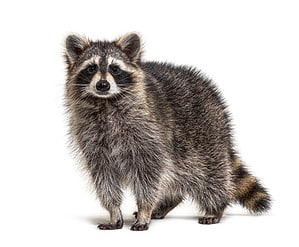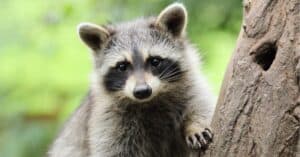Raccoons are medium-sized mammals that belong to the Procyonidae family. They are native to North America. These creatures have distinctive physical features such as black masks around their eyes, bushy tails with alternating light and dark rings, and dexterous front paws with five toes that enable them to grasp objects like humans do.
Raccoons are omnivorous animals which means they eat both animals and plants. Their diet primarily consists of insects, nuts, fruits, rodents, rabbits, or eggs, if available in large quantities during the breeding season.
In addition to being physically unique and adaptable, these scavengers are opportunistic feeders who inhabit various habitats, from forests and wetlands to urban areas, where they thrive on human food waste found in garbage cans, dumpsters, gardens, pet food bowls, etcetera.
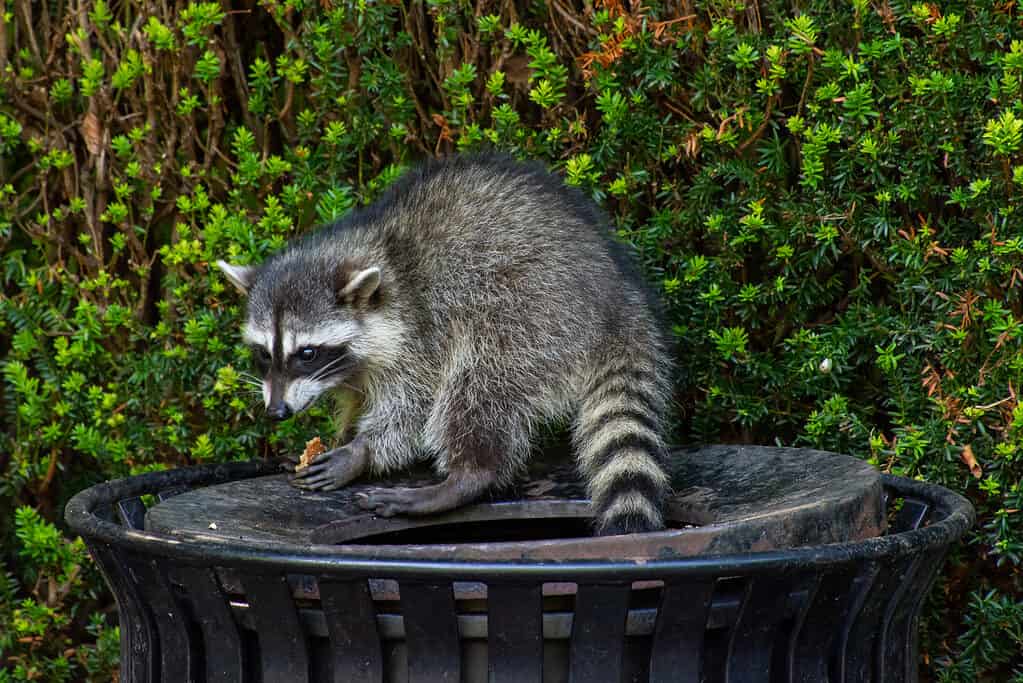
A raccoon steals food from the trashIn addition to being physically unique and adaptable, these scavengers are opportunistic feeders who inhabit various habitats.
©kingma photos/Shutterstock.com
The Den
Raccoons need vertical structures to climb in order to feel safe, so they stay away from open terrain and places with a lot of beech trees. They like to nest in hollows of old oak trees, rock crevices, burrows dug by other animals, and tree crotches. If these places are not available, they will use dense shrubbery for shelter.
Research done in Germany showed that the majority (60%) of raccoon dens were used only once, but those that were used more than ten times made up 70% of all den use. Raccoons prefer areas with lowland deciduous or mixed forests that have plenty of water and marshland, as these locations have the highest population densities, ranging from 1.3 to 8.3 animals per square mile on prairies and not usually exceeding 15.5 animals per square mile in upland hardwood forests. However, in marshes and lowland forests, populations can reach up to 51.8 animals per square mile!

Raccoons like to nest in hollows of old oak trees, rock crevices, burrows dug by other animals, and tree crotches.
©Georgi Baird/Shutterstock.com
Reproduction
Raccoons are nocturnal animals and were previously thought to be solitary creatures, but recent evidence shows they live in gender-separated groups. Female raccoons that are related to each other will often meet up in common areas and eat or rest together.
Mating season for raccoons usually occurs between January and March, with most females beginning reproduction at the age of one. When the days start to get longer, the male raccoons will start roaming their territory in search of a female. Courting takes a few days, and copulation is attempted more than once for the best chance of success. Females have a 55-70 day gestation period and usually give birth to two to five babies. Raccoons are typically born between March and April. If the weather is particularly cold, they may wait to mate and have their babies in June, but this is less common.
Babies
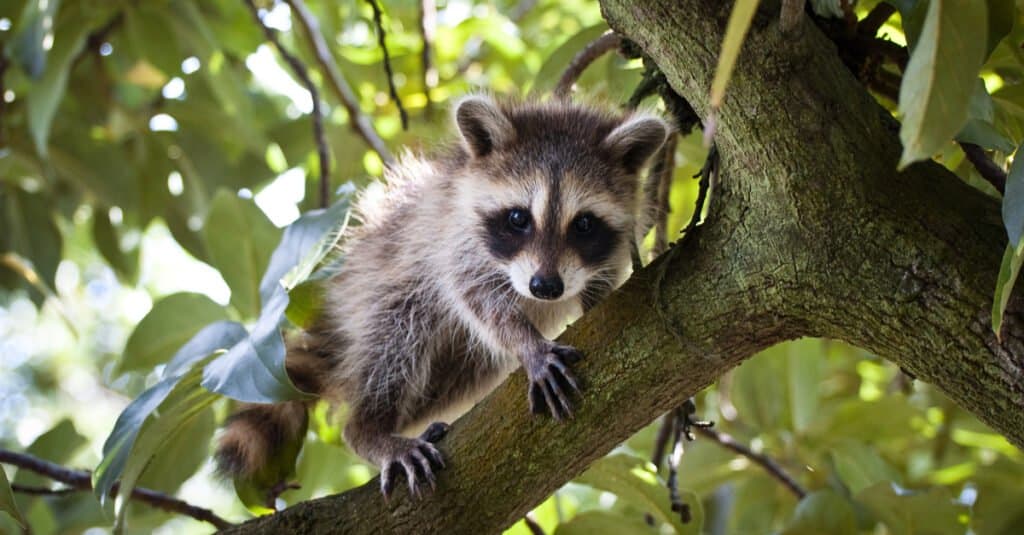
Baby raccoons are called kits, and they are generally born in the early spring months of March to April.
©Heiko Kiera/Shutterstock.com
A mother raccoon usually raises her babies alone, with the male not involved. Newly born kits already have visible black masks. They are deaf and blind at first and weigh only 2 ounces. They start to hear when their ears open between 19-22 days old. A few days after that, their eyes open, and they can see for the first time. They do not leave the den at all until they weigh two pounds. They are unable to eat solid food until they are 6-9 weeks old.
First Months
The kits stay cozy inside the den with their mom until they are around two to three months old and will stay with her until they are one year of age. She nurses them for a full 16 weeks at minimum. Baby raccoons are called kits, and they are generally born in the early spring months of March to April, though if the first litter does not make it, a second litter may come as late as June.
During their first two to three months of life, the baby raccoons will stay in their den and likely not be seen. Afterward, they will start exploring and searching for food with their mother’s guidance. In spite of this, they may remain in the same den with her even during the winter season. It is not until October of their first year that they can become independent from their mom. Female babies will often stay in the same territory as their mothers for a lifetime, forming part of a social group. It is very common for them to share a den during the first winter.
Where Do They Give Birth?
Raccoons tend to give birth in enclosed areas that are sheltered from the elements. In the past, they favored hollow trees and logs but have had to become more creative in finding spots due to human interference. They often select under sheds and decks as nest sites, so please do not attempt to capture them with live traps, as their babies are likely to be left behind and starve to death.
Diet
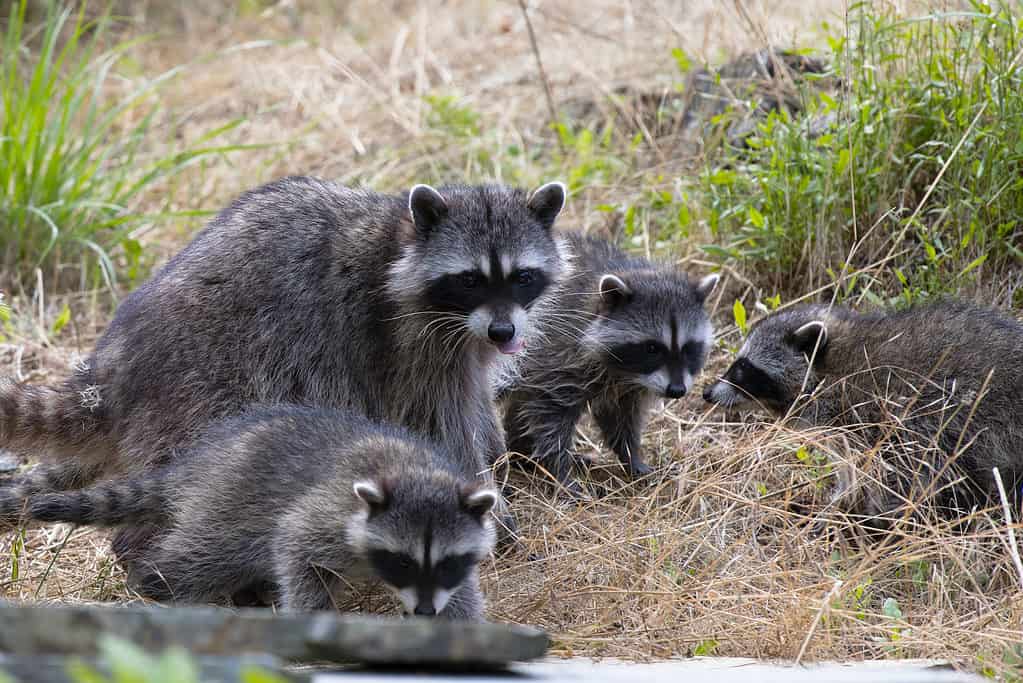
Raccoons are usually active at night but may come out during the day to look for food.
©iStock.com/Wirestock
Raccoons are usually active at night but may come out during the day to look for food. Their meals consist of nearly equal parts invertebrates, plants, and vertebrates, making them one of the most varied eaters around. In the spring and beginning of summer, they like to eat bugs, worms, and other types of food available at the time. As autumn approaches, they switch to fruits and nuts like acorns and walnuts. This allows them to store energy for the winter.
Contrary to what is commonly thought, raccoons normally do not seek out large animals such as birds and mammals as their primary source of food. Rather, they mainly feed on insects, crayfish, fish, small amphibians, and bird eggs. Raccoons are known for their destructive behavior when it comes to nests. This can be detrimental to certain vulnerable species of turtles. When food is plentiful, raccoons develop a preference for certain foods. In the colder areas of their range, raccoons enter a hibernation-like state during winter when it is harder to find food due to the snow cover.
“The Washer”
The raccoon is known for its behavior of taking food items in its front paws, examining them, and then rubbing them, often in water. This behavior is part of the animal’s scientific name, Procyon lotor, which means ‘washer’ in Latin. Water softens the hard layer on the paws. This makes them more sensitive to touch when the rubbing action is performed in the water.
When kept in captivity, raccoons have been observed to carry their food to nearby water sources to “wash” it before eating. However, this behavior has not been seen in the wild. One scientist hypothesized that raccoons do not have enough saliva to moisten their food, but this has since been disproved. It appears that captive raccoons are more likely to douse their food if there is a water source less than 10 feet away. It is thought that this behavior is an extension of the dabbling behavior raccoons use when foraging for aquatic foods. Dirtiness does not appear to be the reason for the “washing.”
Life Span
In captivity, raccoons can live for more than two decades. However, in the wild, their average lifespan can range from 1.8 to 3.1 years. This is depending on the local environment and conditions such as hunting, traffic, and extreme weather. It is common for only half of the babies born each year to survive for a full year. After this point, the mortality rate decreases to between 10-30%. Young raccoons are vulnerable to starvation and losing their mother, particularly in long and cold winters. The most frequent cause of death in North American raccoon populations is distemper. This can become an epidemic and kill most of the local population.
Predators and Threats
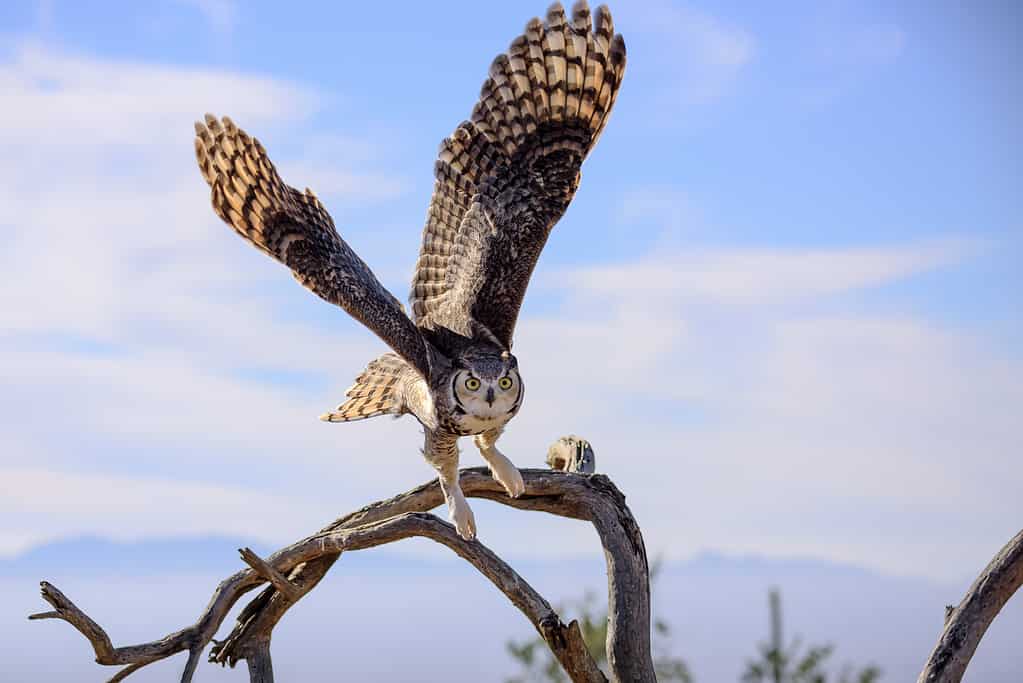
Owls will primarily target baby raccoons but occasionally kill adults.
©iStock.com/kojihirano
In places with a lot of cars and hunting, these factors are responsible for nearly all of the deaths of adult raccoons. Coyotes, bobcats, and great horned owls are the most significant natural predators of raccoons. Owls will primarily target baby raccoons but occasionally kill adults.
In the state of Florida, raccoons are vulnerable to the predation of larger carnivorous mammals such as black bears and Florida cougars. Furthermore, gray wolves may hunt raccoons in some locations. Additionally, alligators are known to target raccoons in the southeastern United States. Bald and golden eagles have also been known to prey on them.
Within tropical regions, raccoons can be preyed upon by smaller eagles, such as black hawk eagles and ornate hawk eagles. In rare cases, they may also be killed by carnivores that are larger or smaller than them. These include fishers and jaguars in Mexico. In their introduced range in the former Soviet Union, lynxes, wolves, and Eurasian eagle owls are their main predators.
The photo featured at the top of this post is © Becky Sheridan/Shutterstock.com
Thank you for reading! Have some feedback for us? Contact the AZ Animals editorial team.



